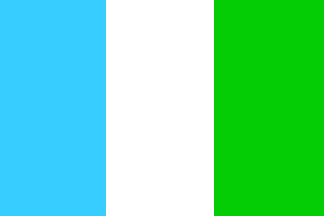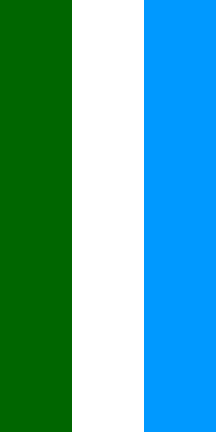
image by António Martins, 30 April 1999

Last modified: 2012-12-31 by rob raeside
Keywords: italy | trentino-alto adige | south tyrol | trento | ladins | bolzano |
Links: FOTW homepage |
search |
disclaimer and copyright |
write us |
mirrors

image by António Martins, 30 April 1999
See also:
An important flag used in Alto-Adige is the flag of ladin
people: horizontal blue-white-green. Sometimes it can be seen
with local civic arms on it.
Mario Fabretto, 20 September 1996
Giuseppe Bottasini described the a flag from <www.provincia.bz.it> as
"Ladins in South Tyrol, Italy" 2:3 (Vertical 3:
lightblue, white, lightgreen). Interesting pattern, no? The
austrian tyrolians fly a horizontal tricolor, while the italian
tyrolians fly a vertical one .I wander about the different blue
shades, though.
António Martins, 30 April 1999
"Patrje Ladine (Ladins) - North Italy." - Horizontal
blue-white-green.
AFAIK There are ca. 30,000 ladin speakers in Italian Su''dtirol
and a
few of them in some valleys of Rhetian Alps (Switzerland). Flag
similar to Aran (Spain).This flag is listed under number 46 at
the chart "Flags of Aspirant Peoples" [eba94].
Ivan Sache
I found a picture of the Ladin flag flying at the La Usc Di
Ladins site which is an online Ladin language journal .The flag
can be found at <www.lauscdiladins.com>.
Marko Puljic, 11 December 1999
About the Ladin flag they told me the following meaning of the
colours: The flag symbolizes the landscape: blue for the sky,
white for the mountains and green for the meadows.
Karl Palfrader, 11 August 2001
According to <www.vejin.com>,
the flag was created in 1920 during a meeting of Ladins. The text
also confirms what has already been stated regarding the meaning
of the colors of the Ladin flag: blue for the sky, white for the
mountains and green for the meadows.
Marko Puljic, 28 August 2002

image by Marco Lambruschi, 25 January 2004
According to Gilberto Oneto article published on "ETHNICA
popoli e culture" November 1993, the Ladine flag is
rapresented with the Grigioni Goat in the white stripe.
Marco Lambruschi, 25 January 2004
Grigioni is of course also known as Grischun (Rumantsch),
Graubunden (German) or Grisons (French). The goat is more
precisely an ibex, whose meaning is explained on Graubünden / Grischun canton (Switzerland).
It is stated that, although most Ladins live in Italy, a few of
them live in the Rhetian Alps, therefore in Switzerland. I wonder
if the flag sent by Marco is not specifically used by those Swiss
Ladins.
Ivan Sache, 10 February 2004
As it looks we can't regard the flag with the ibex as the
official Ladine flag. I asked Mateo Taibon, who is the
coordinator of the Council for Ladinic Problems (<www.vejin.com>
or <tinyurl.com>)
and responsible for the Ladine page of the Society for Threatened
Peoples (<www.gfbv.it>
or <tinyurl.com>).
He writes that the information in the ETHNICA journal is wrong,
the Ladine flag does have the colours blue, white and green but
does not contain an ibex or anything else. Its colours
represent the blue sky, the snow covered mountains and the green
pastures of "Ladinia". This flag is also showed on the
two mentioned websites. He further writes that there are some
folkloristic versions on local level but none of them is the
official Ladine flag. Maybe the flag with the ibex is such an
example.
Martin Karner, 13 February 2004
I never saw such a flag in the Grisons canton nor heard about
it. Gion A. Derungs from the organization "Lia
Rumantscha" (Romansh language) confirmed to me that the
"Swiss" Romanshs* (that's how the Ladins call
themselves here) don't have an own flag. It's a bit complicated
with the terms Ladin and Romansh. "Romansh" can be used
as generic term for the "Swiss" Romansh, the Italian
Ladinic and the Friulic (Italy) dialects. If you look to the
language map of the Grisons canton at <www.liarumantscha.ch>
(on that website you find also a Romansh-English dictionnary),
you can see that there are also two areas of Ladinic idioms (the
white areas are German or Italian speaking). As for the
"Swiss" Romanshs, it is correct to say that they speak
Romansh (even if they come from the Ladinic sub-areas), but on
the other hand, no Italian Ladine would call himself a Romansh,
they just use the term Ladine (as far as I can see).
*"Swiss" is just meant as an adjective and it's not
part of the name. The Romanshs just call themselves and their
language "Romansh" or "Rheto-Romansh".
Martin Karner, 19 and 21 February 2004
During my visit in In Italy, I saw many ladins flags in many
shapes. Flags with horizontal stripes near Pso di Costalunga (Trento
Province, Trentino-Alto Adige Region) and Cortina d'Ampezzo (Belluno
Province, Veneto). Flags with vertical stripes at Vigo/Vich (Trento Province,
Trentino-Alto Adige Region) and .Borca di Cadore (Belluno
Province, Veneto).
Dov Gutterman, 20 October 2004
Those of you interested in winter sports might have noticed
this morning (19 December) the Ladin flag waved by a supporter
during the men's super-g of Alta Badia. The flag was the
horizontal version of the Ladin flag. The ski resort of
Alta Badia, the Mecca of super-g, is located in Sudtirol, and
therefore the Ladin flag was not off-topic. Several members of
the Italian national winter sport teams come from Sudtirolian
dynasties, as can be guessed from their German-sounding names
(for instance the families Plank, Kostner, Moelgg, Huber and
Pallhuber).
Ivan Sache, 20 December 2004
It's impossilble to see the ladin flag (horizontal blue white
green) in Switzerland or in other places. This flag can only be
seen in the following northern italian valleys:
Val Badia,
Val Gherdeina,
Val de Fascia,
Val de Fodom,
Val de Anpez;
Often the Romansh, a people in Switzerland, and the Friulans, a
people in north-eastern italian region Friuli Venezia Giulia, are
referred to as they were Ladins too. But this isn't the right
definition. Ladins, Romansh and Friulans belong to the same
language family: the Rhaeto-Romance family, which is a subfamily
of the Romance languages. The languages Ladin, Romansh and
Friulan are therefore closely related but three different ones.
The flag refers only to the Ladins and it was created on 5th May
1920 on Ju de Frara where the first general Ladin Meeting took
place. The official flag is the simple horizontal blue, white,
green, with no symbol. There are some which have also symbols or
even coats of arms of Ladin families or municipalities, but these
are are only created by irrelevant people or organizations, no
official institutions.
Matthias Crepaz, 15 November 2006

image by Jorge Candeas, 25 April 2005
Photo that I have and taken in front of Cësa di Ladins
shows a vertical flag of the Ladins, a vertical tricolour of
green, white and blue. The most noticeable characteristic of this
flag is that the shade of green is very, very dark, nearly black,
which differs from the green in the ladin flags we show above. As
for the rest, the proportions seem to be close to 2:1 and the
blue is light, but not as light as the top image in this page.
Jorge Candeas, 25 April 2005
There are two versions of vertical flags. The other variant is
with horizontal stripes. It seems that there is no specifications
fro "ladins green" and it is not "nearly
black". Compare the Italian green and Ladins green at the
photos and you see what I mean. I check all my photos, and it
seems that the shade of green in Ladins flag is not consistent,
so there is no single "Ladins green".
Dov Gutterman, 25 April 2005